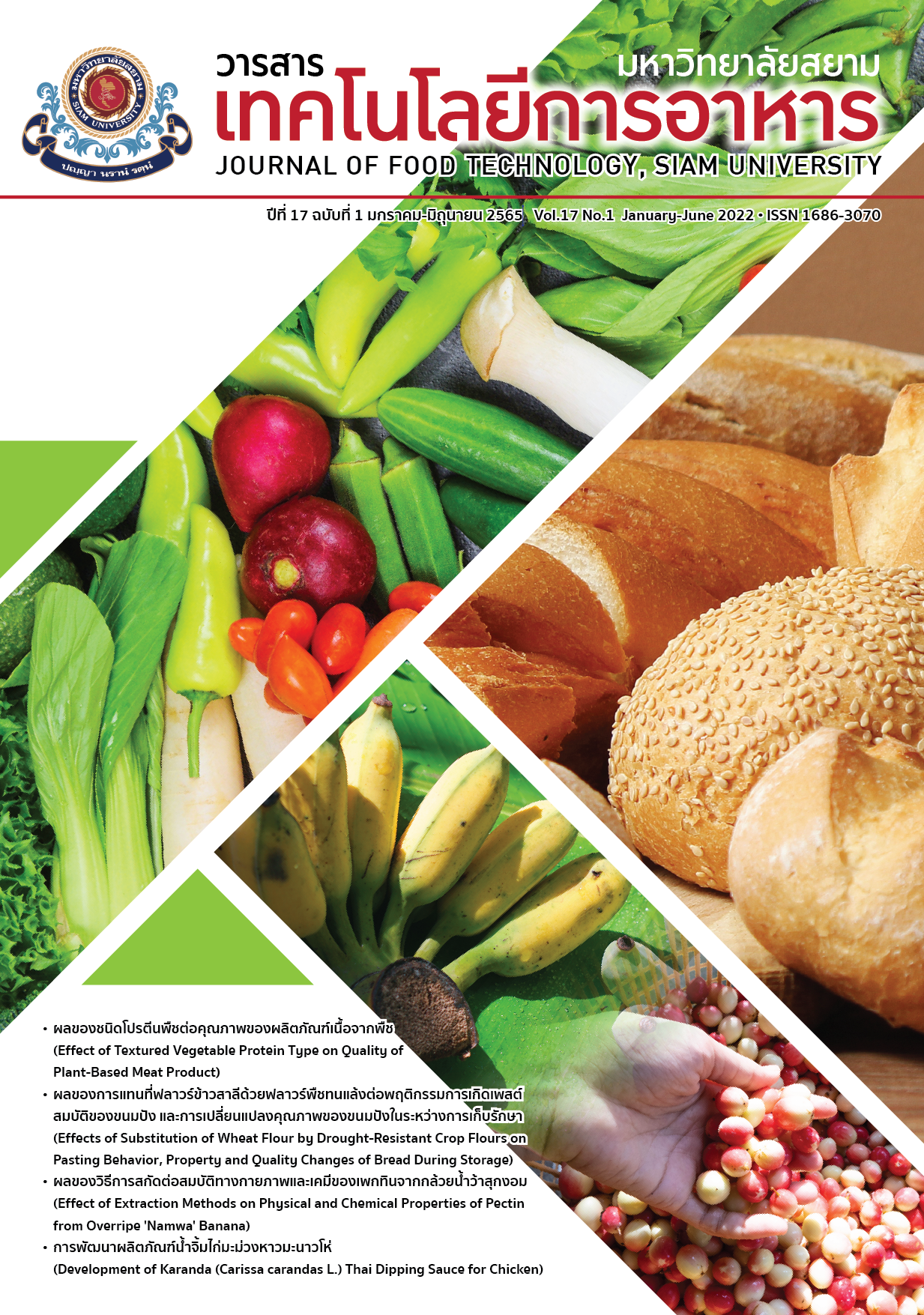Development of Karanda (Carissa carandas L.) Thai Dipping Sauce for Chicken
Main Article Content
Abstract
The aims of this research were to select the basic recipe and develop Thai dipping sauces for chicken from karanda juice, which was used to replace vinegar at 0, 25, 50, 75 and 100%, respectively. The panelists gave the highest score and accepted Thai dipping sauce for chicken from karanda juice at 100% substitution level, especially the odor and taste scores (p<0.05). The effect of karanda juice used to replace vinegar on the characteristics and qualities of karanda Thai dipping sauce for chicken was also studied. For physical properties, the color of karanda Thai dipping sauce for chicken 100% was darker, due to the color of karanda fruits and viscosity value was higher than basic Thai dipping sauce (p<0.05). For chemical properties, the total soluble solid of karanda Thai dipping sauce for chicken 100% was 64.50±0.01 °Brix, pH value was 2.99±0.03, total acidity was 1.82±0.02%, total phenolic content was 0.75±0.00 mg GEA/g sample and DPPH scavenging radical activity was 6.25±0.00 µmole Trolox/g sample. In addition, karanda juice used to replace vinegar in Thai dipping sauce for chicken was found to have higher carbohydrate content and calorie than basic recipe Thai dipping sauce. Karanda Thai dipping sauce for chicken was safe from pathogens and spoilage microorganisms, which complied with the standard for Thai dipping sauce.
Article Details

This work is licensed under a Creative Commons Attribution-NonCommercial-NoDerivatives 4.0 International License.
Copyrights of all articles in the Journal of Food Technology available in print or online are owned by Siam University and protected by law.
References
Svangnabha. (2019). Daily news variety column: A variety of flavors ‘dipping sauces’ the charm of Thai foods set. [Online] Available from http://bit.ly/38WIqb2 [Accessed December 15, 2021]. (In Thai).
Thai Industrial Standards Institute. (2013). Thai community product standard: Dipping sauce for chicken, tcps. 514-2556.
Maheshwari, R., Sharma, A. and Verma, D. (2012). Phyto-therapeutic significance of karaunda. Bulletin of Environment Pharmacology and Life Sciences. 1(12): 34-36.
Watrabut, S. (2010). Chemical constituents of karanda fruit (Carissa caranda Linn.). Unpublished bachelor’s thesis, Rambhai Barni Rajabhat University, Chanthaburi, Thailand. (In Thai).
Chaovanalikit, A. (2011). Extraction and analysis of anthocyanin. Journal of Science and Technology, Srinakharinwirot University. 3(6): 26-36. (In Thai).
Puttame, K., Sawasdikarn, J. and Chitphutthanakul, S. (2016). Effect of karanda fruit (Carissa caranda Linn.) and water ratio on physical, chemical properties and sensory quality of karanda. Rajabhat Rambhai Barni Research Journal. 10(3): 114-118. (In Thai).
Pewlong, W., Sajjabut, S., Singphet, S. and Eamsiri, J. (2013). Influence of fruit ripening stages on the bioactive compounds of Carissa carandas. Agricultural Science Journal. 44(2)(Suppl.): 337-340. (In Thai).
Maeban. (2012). Dipping sauces, salad dressing seasoning. Maeban, Bangkok. (In Thai).
Sangdad. (2008). 121 Delicious dipping sauces. (3rd ed.). Sangdad Publishing,Bangkok. (In Thai).
Nicolas, L., Marquilly, C. and O’Mahony, M. (2010). The 9-point hedonic scale: Are words and numbers compatible?. Food Quality and Preference. 21(8): 1008-1015.
Rittilert, P. (2017). Handbook for dried osmotic dehydrated fruits processing: Karanda Fruit (Carissa carandas L.). (1st ed.). Pathum Thani: Faculty of Agricultural Technology, Valaya Alongkorn Rajabhat University under The Royal Patronage. (In Thai).
AOAC. (2006). Official methods of analysis. (18th ed.). Association of Official Analytical Chemists. Gaithersburgs, MD.
AOAC. (2016). Official methods of analysis. Association of Official Analytical Chemists.
Washington D.C.
AOAC. (2019). Official methods of analysis of AOAC international. (21st ed.). Gaithersburg, Maryland.
AOAC. (2012). Official method of analysis. (19th ed.). Association of Official Analytical Chemists. Washington D.C.
Maizura, M., Aminah, A. and Wan Aida, W.M. (2011). Total phenolic content and antioxidant activity of kesum (Polygonum minus), ginger (Zingiber officinale) and turmeric (Curcuma longa) extract. International Food Research Journal. 18: 529-534.
Zigoneanu, I.G., Williams, L., Xu, Z. and Sablior, C.M. (2007). Determination of antioxidant components in rice bran oil extraction by microwave-assisted method.Bioresource Technology. 99: 4910-4918.
BAM. (2001). Bacteriological Analytical Manual Online. Food and Drug Administration: Silver Spring, MD.
ISO. (2017). ISO 6579-1: 2017. Microbiology of the food chain - Horizontal method for the detection, enumeration and serotyping of Salmonella- Part 1: Detection of Salmonella spp. Geneva, Switzerland.
BAM. (2016). Bacteriological Analytical Manual Online. Food and Drug Administration: Silver Spring, MD.
Williams, L.J. and Abdi, H. (2010). Fisher’s Least Significant Difference (LSD) Test. In N. Salkind. (Ed.), Encyclopedia of Research Design. (pp.154). Sage, Thousand Oaks.
Rittilert, P. and Warin, K. (2020). Development of karanda (Carissa carandas L.) gummy jelly product. Thai Journal of Science and Technology. 9(2): 342-354. (In Thai).
Tatongjai, K. and Laokuldilok, T. (2018). Effects of purple rice bran addition on the physiochemical-sensorial properties and storage stability of Chinese sausage. Journal of Food Technology, Siam University. 13(1): 44-57. (In Thai).
Suwannalers, P. (2012). Development of butterfly pea kalamae product. Chiang Mai Rajabhat University. [Online] Available from http://cmruir.cmru.ac.th/handle/ 123456789/156 [Accessed January 15, 2021]. (In Thai).
Lisnund, S. and Srihaphong, S. (2015). Ultraviolet spectrophotometric for determination of ascorbic acid in pharmaceutical tablets and carambola fruit by sodium thiosulfate solution. Rajamangala University of Technology Tawan-ok Research Journal. 8(2): 92-100. (In Thai).
Kumar, S., Gupta, P. and Gupta K.L.V. (2013). A critical review on karamarda (Carissa carandas Linn.). International Journal of Pharmaceutical and Biological Science Archive. 4(4): 637-642.


